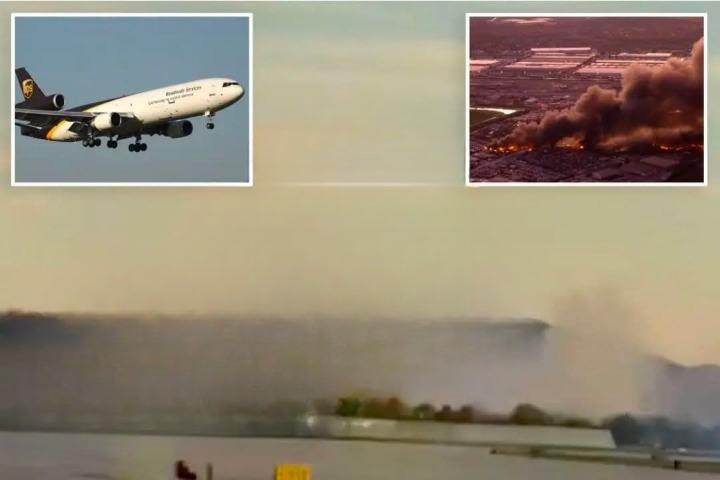On August 16, 2025, what began as a routine flight from Corfu, Greece, to Düsseldorf, Germany, turned into a tense and unforgettable ordeal for passengers aboard a Condor Airlines Boeing 757. About midway through the journey, the aircraft experienced a serious technical malfunction that resulted in visible flames from one of its engines. The incident prompted an emergency landing in Brindisi, southern Italy, where all passengers and crew members disembarked safely.
Though terrifying in the moment, the event ultimately showcased the precision of aviation safety systems and the professionalism of Condor’s crew, whose swift and coordinated actions prevented tragedy. What followed was a night of uncertainty, gratitude, and reflection for those who had stared fear in the face at 36,000 feet.
A Routine Takeoff Turns into the Unthinkable
Flight DE 2743 departed from Corfu International Airport under perfect summer skies. For most of the 180 passengers, the trip was the relaxing finale of a Greek vacation — a short, direct route home to Germany aboard a well-regarded European carrier. The plane climbed steadily into the blue horizon, reaching its assigned cruising altitude above the Ionian Sea.
Approximately 40 minutes into the flight, as the aircraft leveled off, some passengers seated on the left side began to notice something unusual: flashes of orange light reflecting against the wing. At first, a few thought it might be sunlight or a passing reflection, but the glows intensified, soon accompanied by popping noises that sounded out of place on a smooth flight. Within seconds, the cabin filled with the faint smell of smoke.
The mood changed instantly. Conversations stopped, children clutched their parents, and anxious faces turned toward the windows. Someone shouted that they could see fire outside. What had been a peaceful journey now felt dangerously uncertain.
Fear Spreads Through the Cabin
Witnesses later told reporters that the sight of the burning engine created an immediate wave of panic. “You could see the orange glow flickering across the window,” one passenger said to Bild. “Then came a sound like metal cracking, and suddenly, the engine looked like it was spitting flames.”
For those inside the aircraft, moments stretched into what felt like hours. The plane’s vibrations changed slightly, and several passengers reported sensing a shift in altitude. A few began texting loved ones — short, emotional messages that they feared might be their last.
Another passenger recalled: “I told my husband and children, ‘I love you, I’m sorry.’ It was the only thing I could think to write. You realize how powerless you are in that moment.”
While distress rippled through the cabin, the cockpit crew acted with trained precision. Following international aviation protocol, the pilots immediately identified the malfunctioning engine, shut it down to prevent further damage, and began coordinating with air traffic control for an emergency diversion. Their calm professionalism, though largely unseen by the passengers, set the stage for the safe outcome that followed.
The View from the Ground
As the aircraft began its descent, several people on the ground in southern Italy noticed flashes in the sky. Videos recorded from mobile phones showed what appeared to be streaks of fire trailing from the right engine of the Boeing 757. Social media quickly filled with speculation that a plane was in distress, with some fearing they were witnessing a crash in progress.
Authorities later confirmed that the bright flames seen from the ground were caused by a disruption in turbine airflow, a type of engine malfunction that can produce short bursts of visible fire. Though dramatic, such events do not necessarily indicate a full engine fire, and modern aircraft are designed to manage them safely through redundancy systems and pilot control measures.
Aviation experts later emphasized that what passengers saw was likely a combustion reaction at the engine’s rear exhaust — not a sustained fire. Still, the sight was understandably alarming for those on board, especially with no immediate information available in the cabin.
The Emergency Diversion to Brindisi
Within minutes of detecting the issue, the flight crew declared a Mayday emergency and requested immediate clearance to divert to Brindisi Airport — the nearest major facility equipped to handle an emergency landing of a Boeing 757. Air traffic controllers in both Italy and Greece coordinated rapidly, clearing the airspace and preparing emergency services on the ground.
For the next 20 minutes, the aircraft continued flying safely on its single remaining engine. Passengers sat in tense silence as the crew reassured them that the situation was under control. Many later described the sound of the cabin as “eerily quiet,” with every vibration magnified by anxiety.
One traveler recalled, “You could hear the landing gear deploy, and everyone started clapping softly — not because we were safe yet, but because we knew the end of the ordeal was near.”
Touchdown and Relief
As the plane descended toward Brindisi, emergency response teams were already stationed along the runway, ready for any outcome. The pilots executed a smooth, controlled landing, bringing the 757 safely to a halt as applause, tears, and sighs of relief erupted throughout the cabin.
When the engines finally powered down, passengers hugged, prayed, or simply sat in silence. Fire crews immediately approached and inspected the malfunctioning engine. Despite the earlier visuals of flames, there was no ongoing fire. The incident was contained, and all passengers and crew were unharmed.
Condor Airlines issued an immediate statement confirming that the diversion was precautionary. “Passenger safety is our highest priority,” the company said. “The aircraft diverted to Brindisi following abnormal engine readings. At no point were passengers or crew in actual danger.”
A Night of Waiting and Gratitude
Though the danger had passed, the disruption left travelers stranded overnight in Brindisi. With limited accommodation available during the busy summer season, some passengers slept in the airport terminal, while others were provided with meal vouchers and temporary lodging. Condor staff remained on-site to assist, offering updates and ensuring medical and emotional support for those shaken by the experience.
One passenger expressed frustration online, writing, “We just went through something terrifying, and then we had no idea when we would fly again.” Others, however, praised the crew’s conduct, noting that the flight attendants stayed calm and compassionate throughout.
Condor later apologized for the delay and inconvenience, confirming that all passengers would be reimbursed for additional expenses and provided transport on a replacement aircraft to Düsseldorf the following day.
Investigating the Cause
A technical team from Condor and independent aviation inspectors traveled to Brindisi to examine the damaged engine. Early reports pointed to an airflow disruption within the turbine system, likely caused by a mechanical or material fault that triggered a brief combustion reaction. Such occurrences, while rare, are not unprecedented and are typically managed through established emergency protocols.
According to aviation analyst Lars Becker, “The visuals of an engine emitting flames can look catastrophic, but in reality, modern jet engines are built with containment systems that prevent damage from spreading. Aircraft like the Boeing 757 are fully capable of flying safely on a single engine for extended periods.”
The aircraft remained grounded pending a detailed investigation. Condor emphasized that maintenance and inspection schedules would be reviewed to ensure continued adherence to European safety standards, which are among the strictest in the world.
Understanding Engine Malfunctions
While the experience was distressing, aviation experts were quick to explain that such incidents are statistically rare and usually well within the design tolerances of modern commercial aircraft. Each Boeing 757 engine operates independently, allowing the plane to continue safe flight even if one engine fails or is intentionally shut down.
Engine “flameouts” or “backfires” can occur due to sudden disruptions in airflow, fuel flow irregularities, or sensor malfunctions. Though they can produce visible bursts of flame, pilots are trained to respond immediately using standard checklists to isolate and stabilize the issue.
The European Aviation Safety Agency (EASA) maintains strict oversight on all such events, requiring airlines to report, analyze, and correct any anomalies. Condor’s compliance record and operational safety history remain strong, and preliminary reports from Italian authorities reaffirmed that the crew’s response followed all proper procedures.
Passengers Reflect on the Experience
For those who lived through the forty minutes of uncertainty, the event left lasting emotional impressions. Many described it as a moment that reshaped their understanding of air travel — not just as a convenience, but as a technological and human achievement that demands respect.
“I fly often, and I never think twice about it,” said one German traveler. “But that night reminded me how much trust we place in the people and systems that keep us safe.”
Others expressed gratitude toward the pilots and flight attendants. “They were calm when we couldn’t be,” one woman said. “That calmness probably saved us from chaos.”
Passengers later reunited in online forums and shared supportive messages, with some forming long-term friendships after bonding through shared fear. Despite the initial terror, many agreed that the experience had deepened their appreciation for aviation safety and life itself.
The Broader Aviation Perspective
While the incident was unusual, it underscored how robust aviation safety measures have become. Globally, commercial air travel remains one of the safest forms of transportation, with accident rates at historic lows thanks to advances in engineering, pilot training, and real-time monitoring technology.
Incidents like Condor Flight DE 2743’s emergency landing are analyzed meticulously, not only to determine causes but also to improve systems and prevent future recurrences. Every mechanical failure, even a minor one, becomes a learning opportunity for manufacturers, regulators, and airlines alike.
Condor Airlines, founded in 1955, has a long-standing reputation for safety and reliability. The company operates under the supervision of German and EU aviation regulators, with maintenance standards that meet or exceed international requirements. Following the Brindisi event, the airline reaffirmed its commitment to transparency, safety, and continuous improvement.
From Crisis to Confidence
By the following afternoon, a replacement aircraft arrived in Brindisi to take passengers to their original destination in Düsseldorf. The relief on faces was visible — exhaustion mixed with quiet gratitude. Many described the final leg of the journey as serene, even uplifting. “Everyone clapped when we landed,” one passenger said. “But this time, it wasn’t fear — it was appreciation.”
Aviation authorities commended the Condor crew for their professionalism and the pilots for their flawless execution under pressure. Analysts noted that the safe resolution of the emergency reflected the strength of airline training and the redundancy of modern aircraft systems.
A Lesson in Safety, Humanity, and Trust
In hindsight, what happened on that August evening was not just a technical failure but a reminder of resilience — both mechanical and human. From the pilots who remained calm in crisis, to the passengers who supported one another through fear, the flight became a story of cooperation, trust, and survival.
As one traveler put it afterward:
“When you see flames outside your window, you think of everything you’ve left undone. But when you land safely, you realize how much you still have to live for.”
For Condor Airlines, the incident became a reaffirmation of its mission: that every journey, no matter the distance, begins and ends with safety as the guiding principle.
Conclusion
The Condor Boeing 757 emergency landing will be remembered not as a disaster, but as a testament to how far aviation safety has come. A malfunction that once might have spelled catastrophe instead became a controlled, textbook example of crisis management and pilot expertise.
Though the 40 minutes of tension left emotional scars for some, it also left behind gratitude — for skilled pilots, resilient aircraft, and the systems designed to protect lives at high altitude.
In an age where millions of people fly every day, the story of Flight DE 2743 stands as a reassuring reminder: even when the unexpected happens, aviation professionals are prepared to bring everyone home safely.




